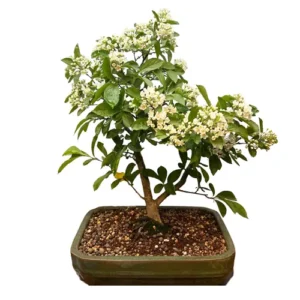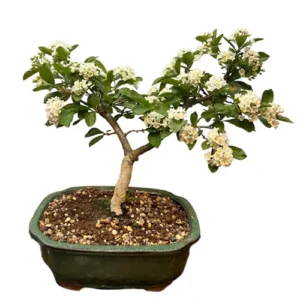Thymus serpyllum
Thyme Bonsai
Native to dry grasslands across Asia and Europe. Thymus serpyllum is a dwarf evergreen shrub adorned in aromatic leaves and can blossom elegant mauve to white flowers. These woody evergreen perennials are a popular choice for accessory plants.
Thyme Bonsai Care Tips
Placement
Thyme Bonsai should be provided full sun where they are placed. While a hardy species they do require protection from frost. When planted in small pots be vigilant for temperatures below -5 degrees C, as this could demand moving to a more suitable insulated area, conservatory or greenhouse.
Watering
Considering the dwarf scale of Thyme, you need to be mindful of the smaller body of soil it’s kept in and the speed at which this can dry out. In a temperate region like the UK, Thyme Bonsai need watering regularly but be sure not to overwater. Judge watering by the moisture of the soil.
Feeding & Fertilising
Using a balanced feed, Thyme bonsai should be fed every two weeks across the growing season.
Pruning & Wiring
Thyme Bonsai’s smaller size and foliage mean continual clipping of leaves is needed to shape the tree. Any hard pruning should take place after the plant has flowered.
Thyme is only suitable for extra small Bonsai styles. It is a lot more commonly used as an accessory or accent plant.
Repotting
Repotting your tree is an important way to provide a fresh and suitable soil mix and ensure appropriate root health. Thyme can be repotted every year at any time, like most Bonsai spring is the ideal time. Consider soil mixes, Thyme heavily dislike acidity and take well to a dash of lime in their soil.
Trees that are ready for repotting will require root pruning, a suitable new pot and appropriate soil mix.
When repotting, do not cut back the root mass by a large amount, and choose a well-draining soil mix. We tend to use a mixture of different speciality bonsai soils on our trees. Every species is different so please contact us for free soil-mix advice or to take advantage of our repotting service.
Bonsai trees aren’t only magnificent additions to an indoor oasis, they are more than capable of standing out in any garden. Many Bonsai species are incredibly hardy and withstand nature’s colder and damper turns with aplomb making them worthwhile outdoor plants. We have an extensive library of care guides for outdoor bonsai trees. It’s not about selecting the perfect bonsai, it’s about selecting the perfect bonsai for you.
Thyme Bonsai - Typical Queries
Can you propagate a Thyme bonsai?
Thyme bonsai can be propagated with both seeds and cuttings. Seeds need sowing outside in the spring. Division should take place in Spring. Softwood cuttings should be taken at the start of Summer. Semi-ripe cuttings in the middle to late summer.
Can Thyme bonsai get pests and diseases?
Thyme bonsai has an adverse reaction to fertilisers and chemicals with an acidic basis. Leaves can be killed or discoloured through excessive moisture. Pests shouldn’t be a likely occurrence for this bonsai.
Can you keep a Thyme bonsai indoors?
Thyme Bonsai is best grown outdoors like the majority of Bonsai species. Indoor growing is possible but the use of artificial lighting is probably unavoidable for a species demanding so much sun.





















